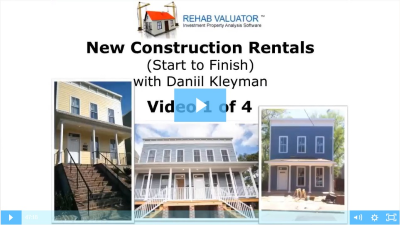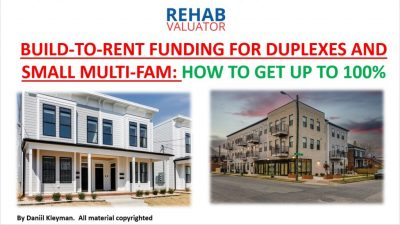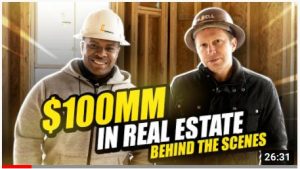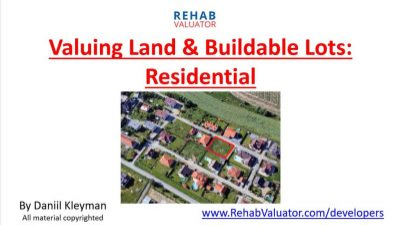How to Analyze and Value Buildable Lots (For Builders and Wholesalers)
Video Transcript Below
Hey, Daniil Kleyman here and this is going to be fairly short video where I want to focus specifically on valuing residential land and buildable lots. If you are watching this, you may come across infill lots in your market or you may come across vacant land and this hopefully will be helpful to you. So, let me move my slides here. Why are we here? Most half-decent investors can figure out value of houses, right? That’s what you’re taught, that’s what you learn first. You go you look at the house what’s it worth. That’s what everybody is teaching but almost nobody understands how to value land, vacant land and specifically really, we’re going to focus on infill lots.
Infill lots are lots that are literally sitting in between other houses and other structures where you can just buy it and put a house on it. So not understanding this keeps… A. keeps a lot of people from doing new construction, B. it also holds back wholesalers from targeting and wholesaling buildable lots. And wholesaling buildable lots is a huge missed opportunity given how many buyers are in the market for lots that are ready to build the houses on. I am one of those buyers. I really want… my wish is to educate more wholesalers in my market about how to do this so that they would continue bringing me deals. So, I'm going to show you how to do this very easily.
Rule number one always work backwards. I think so like this guy. I think this is probably where most people get confused. They look at a piece of land and they don’t know what to do with it. Well, start with the end in mind. When analyzing land or a bit of house it works the same exact way. Forget initially about what's in front of you instead figure out what will be built here and exactly what it will look like. What does the final product look like?
So here is an example. You get this address, maybe you look on Google maps, street view, tax records and this is what you see. Well, it’s hard to make heads or tails of this. But if you figure out what can be built on this and either if you’re building or if your cash buyer is going to build, what they are likely to build here? What are they able to build by zoning and what are they likely to build here? Well, it makes it a lot easier to place a value on this because now you could find comparable sales. So, this is an example of a house that I built and sold a few years ago. And once you’ve picture this it’s easier to then find comparable sales to a house like this. It's easier than comfortable sales for lots are actually harder to come by and they're so different. But if you figure out what's going to be built here what you're going to build, you can back into the value of the land.
So, this is the process. You start with the end in mind. Figure out the after repair or post-construction value. What are you going to build here? Or what does your buyer going to build here? What is it going to be worth, right? So, you pull comparable sales to the house that’s going to be built. Decide on the desired profit margin. So, when we build new construction houses, I’m typically happy with a 22% to 25% net margin, right? The 70% ARV rule these days it’s pretty hard to tap, right? If I’m building a new house and I can hand a 22% to 25% net margin, I’m happy right? And then you back out your cost to build and then you back out closing, financing, holding and selling cost if you’re selling. And this gives you max value of the land or max purchase price.
So let’s look at an example. Let’s say you’ve got a single-family house, 2000 square feet with after construction value. You can call it post-construction, after construction value, ARV. It doesn’t matter, $400,000. That's what you expect to be able to sell this house for. Desired profit margin net is 25%. Cost to build is a hundred bucks a foot. So it's going to cost you $200,000 to build. And then your closing, financing, selling, holding cost we’re going to ball park at 10%. So 6% to 7% of the $400,000 is what it’s going to cost to sell. 6% of your paying realtors. I usually like to include another point in there another percent for concessions, right? Discounts and then the rest of that 10% is my closing, financing and holding cost.
It's a good rule of thumb if you want to do a quick and dirty analysis. So that's $40,000. So here’s the equation. Max Value of Land = $400k x 75% – 200k – 40k = $60k And if your wholesaling to back out your desired fee so your offer to the seller should be $60k minus your desired assignment fee.
So if you want to make 10 grand, you can offer at the most $50,000 to the seller. Very simple, right? It's actually works the same way as analyzing houses, right?
Here's another example, duplex. Let’s say you can build a duplex 2500 square feet with after repair value of $350,000. It costs you less to build because it’s a duplex. You’re not using finishes as nice as in a spec house so it’s going to cost you $225,000 to build a duplex. Your closing, financing, holding cost here are 4% because you’re not selling it so they’re less your desired equity.
So when I build duplexes I want to have 20% sweat equity in the deal when I’m done with construction. So here’s my equation. Max value of land $350,000 – x 80% minus my cost to build minus my closing, financing, holding cost. $41,000 for the duplex is the maximum eyes a builder can pay and again if you’re wholesaling you need to back out your feet out of that $41,000. So if you’re a wholesaler you’re likely not going to know exactly what your eventual buyer is going to build. You’re not going to know the exact square feet, bedrooms, bathrooms, finishes. You’re also not going to know their exact cost to build.
You can guess, you can ball park so that’s really your job as a wholesaler is to make your best guesstimate. You have to make assumptions and you have to get in the ballpark, right? What I just showed you here this works really well if you’re the builder. If you are wholesaling you’ve got to make some assumptions, right? It can be as simple as on similar lots in this area houses are selling in a 325 to 350k range and I'm going to assume they cost a hundred bucks a foot to build, right? That should be enough for you to figure out values that get you in the ball park to make offers and not make mistakes.
You can also try to find comps for lots, right? Single family lots in this neighborhood go 4X. So that's another way in which you can make, you can get to the right data and make the right offers, right? So the most important concept to understand though when doing this you whether you are a builder or whether you're a wholesaler is to understand the zoning.
Is this a lot where a single-family house can be built? Is this a lot where I can build multiple houses where I can split it? Is this a lot where I can build a multi-family property or my buyer can build a multi-family property? The better understanding of zoning you have the more of an edge you will have over everybody else doing marketing in your market to these sellers.
So I have a much more detailed training on zoning analysis and on understanding what can be done with a particular piece of land. You can find it, right you can find it here. If you go to www.rehabvalutor.com/developers and you can find it on RehabValuator YouTube channel as well. And I will try to link to it here somewhere. But let me show you something. In any market you can get access to something like this.
This is a zoning handbook for my particular city where I do a lot of my development. It’s available in every county and if you scroll down here it starts to break down zoning for you. R1 this is residential. Let's enlarge the screen. This is residential zoning codes. You’ve got R1 and then goes down to R2 so when you look at a particular piece of land. Again in my city we have… let me show you something. We have an online tax record system. So if I'm looking at a particular piece of land I'm going to be able to pull it up. Alright, here's my satellite map so I can actually see it’s a vacant lot. I can click it. And it’s going to give me the zoning code. It's going to give me the zoning code so I can go back to my zoning handbook and I can go to R6. And see, ok what can be built here?
What are the requirements to build a structure on this lot? How big does it have to be? And I can go back to my zoning code on my tax records I could see okay, this is a 30 ft wide lot total square feet is this. It’s zoned R6 and I can go to my zoning handbook and say okay given the lot size in the zoning designation, here’s what I can build on it.
Now I can start to determine value right when I figure out what can be built on this lot. Then I can start figuring out the value of what that structure that will be built will be worth. So most builders, definitely most wholesalers, most of us don’t understand zoning. If you can take the time to learn this you're going to be ahead of most people in your market. From here make sure that you check out… we have much more in-depth real estate education. If you go to www.rehabvaluator.com/developers or on the RehabValuator YouTube channel there is content there on rehabbing a new construction. BRRRR, fixing flipping, building rentals, etc. etc.
This is the kind of education that almost nobody offers especially for free. You can sign up for the free version of RehabValuator if you go to www.rehabvaluator.com. It’s going to give you access to the max offer calculator for much easier number-crunching full deal analysis capability. And then of course the paid the premium version allows you to create detailed rehab budgets, template, scopes of work, manage your project start to finish, create funding presentations. If you’re wholesaler you can sell your deals, etc. etc.
So definitely check that out and then leave me a comment here. Share this video if you found it helpful, and if you if there is some specific content that you wish you saw online that you'd like me to record leave them in the comments as well. I'm always open to suggestions. I'm happy to create some additional education for you guys and gals who are watching this. All right, thank you.
Next Videos

New Construction Rentals Training

How to Get Up to 100% for New Build Rentals



Hi Daniil;
The video was insightful and helpful.
Thank you.
So happy to hear that Mamadou! ?
Great Dan one of best I have seen! Financial Consultanr and small time developer.
Appreciate the positive feedback, Frank!
Thank you Daniil, definitely considering building a fourplex this year, 2023!
Hi Daniil, There is no date on these videos so can not tell if they are relevant for today (as of Nov 2022). With increased mortgage rates, falling house values and construction costs not coming down; does this BRRRR strategy still work? Would the cash flows be able to meet DCR of 1.3?
Hi Venu. That’s what the Rehab Valuator software is there for. For you to run the numbers yourself given today’s market and figure it out.
Thank you very helpful re what yo look for in land..thank you gor the free knowledge
Thanks Danil good info- Do you think its a good idea to get a value or ballpark based on what the cou nty charge of land from tax records ?
Lee – I think you’re asking if the tax assessment is a good indicator of value? From my experience, it can be but it’s often wrong as well.
Hi, Excellent information, I plan to pass this information on to my son whose into buying and selling of land. Also plan to address this intormation into my Affilate Program with Rehab Valuator on my website.
Thanks
Danny
Sounds good. Thank you, Danny!